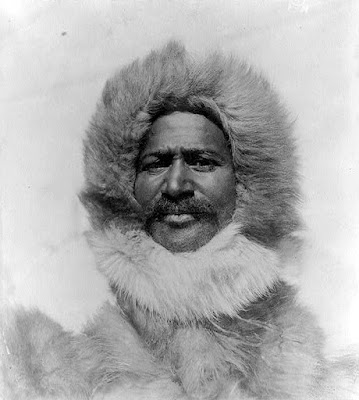TITLE: [Matthew Alexander Henson, head-and-shoulders portrait, facing front, wearing fur hat and fur coat] CALL NUMBER: BIOG FILE - Henson, Matthew Alexander, 1866-1955 [item] [P&P] REPRODUCTION NUMBER: LC-USZC4-7503 (color film copy transparency) LC-USZ62-42993 (b&w film copy neg.)
RIGHTS INFORMATION: No known restrictions on publication.
MEDIUM: 1 photographic print. CREATED, PUBLISHED: c1910. NOTES: J137917 U.S. Copyright Office.
REPOSITORY: Library of Congress Prints and Photographs Division Washington, D.C. 20540 USA, DIGITAL ID: (color film copy transparency) cph 3g07503 hdl.loc.gov/cph.3g07503 (b&w film copy neg.) cph 3a43309 hdl.loc.gov/cph.3a43309, CONTROL #: 00650163
Credit Line: Library of Congress, Prints & Photographs Division, [reproduction number, LC-USZC4-7503]
 | MARC Record Line 540 - No known restrictions on publication. Works published prior to 1978 were copyright protected for a maximum of 75 years. See Circular 1 "COPYRIGHT BASICS" from the U.S. Copyright Office. Works published works before 1923 are now in the public domain. Matthew Henson From Wikipedia, the free encyclopedia Matthew Alexander Henson (August 8, 1866 – March 9, 1955) was an American explorer and long-time companion to Robert Peary; amongst various expeditions, their most famous was a 1909 expedition which claimed to be the first to reach the Geographic North Pole. |
Matthew Henson was born on a farm in a rural Maryland county in 1866. He was still a child when his parents Lemuel and Caroline died, and at the age of twelve he went to sea as a cabin boy on a merchant ship. He sailed around the world for the next several years, educating himself and becoming a skilled navigator. Henson met Commander Robert R. Peary in 1888 and joined him on an expedition to Nicaragua. Impressed with Henson’s seamanship, Peary recruited him as a colleague.
For years they made many trips together, including Arctic voyages in which Henson traded with the Eskimos and mastered their language, built sleds, and trained dog teams. In 1909, Peary mounted his eighth attempt to reach the North Pole, selecting Henson to be one of the team of six who would make the final run to the Pole. Before the goal was reached, Peary could no longer continue on foot and rode in a dog sled.
Various accounts say he was ill, exhausted, or had frozen toes. In any case, he sent Henson on ahead as a scout. In a newspaper interview Henson said: “I was in the lead that had overshot the mark a couple of miles. We went back then and I could see that my footprints were the first at the spot.” Henson then proceeded to plant the American flag.
Although Admiral Peary received many honors, Henson was largely ignored and spent most of the next thirty years working as a clerk in a federal customs house in New York. But in 1944 Congress awarded him a duplicate of the silver medal given to Peary. Presidents Truman and Eisenhower both honored him before he died in 1955.
In 1912 Henson wrote the book A Negro Explorer at the North Pole about his arctic exploration. Later, in 1947 he collaborated with Bradley Robinson on his biography Dark Companion. The 1912 book, along with an abortive lecture tour, enraged Peary who had always considered Henson no more than a servant and saw the attempts at publicity as a breach of faith.
This article is licensed under the GNU Free Documentation License. It uses material from the Wikipedia article, Matthew Henson
Technorati tags: Why the web tells us what we already know and Chinese New Year of the Rat, Wu Zi, 4705 and Nanowires hold promise for more affordable solar cells or Harriet Tubman















No comments:
Post a Comment